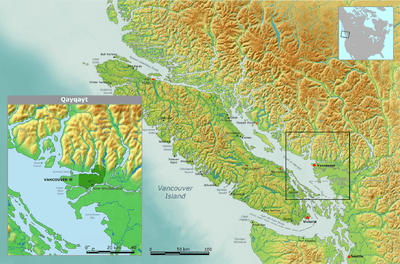Qayqayt First Nation


The Qayqayt First Nation (qiqéyt) (pronounced Key-Kayt), also known as the New Westminster Indian Band, is a band government located at New Westminster, British Columbia. The New Westminster Indian Band - Qayqayt First Nation is recognized by all levels of government, as well as the Assembly of First Nations where they hold delegate status. The Qayqayt First Nation historically spoke the Downriver Dialect of Halkomelem called hən̓q̓əmin̓əm̓, a Coast Salish language.[1] The Qayqayt First Nation is one of the smallest First Nations in Canada and the only one registered without a land base.[2]
History
The people who were permanent residents of the New Westminster Indian Band - Qayqayt First Nation can trace their ancestral roots in the community through the provision of birth records and “band lists” maintained by the Federal Government. This information shows an uninterrupted presence of their population in New Westminster even after the illegal sale of the Reserve Lands.[3] A reserve for the “Langley Indians” (Kwantlen First Nation) was established directly on top of the fishing village of qiqéyt. In 1879, the federal government allocated three reserves as general reserves for “All Coastal Indians.” These reserves were established inclusive of 104 acres (0.42 km2) of the South Westminster Reserve, 22 acres (89,000 m2) on the North Arm of the Fraser River and 27 acres (110,000 m2) on Poplar Island.[2]
On September 4, 1913 George Roberts “of the New Westminster Band of Indians” met with commissioners of the British Columbia, Royal Commission on Indian Affairs. In his interview Roberts acknowledged Musqueam “Chief Charlie”chief of Musqueam and “New Westminster” Indians.[4] Musqueam continued to live at qiqéyt into the 1930s. In 1959 this reserve was sold to pay for a water systems on Musqueam's I.R. #2. qiqéyt continues to be important to Musqueam and they continue to fish in the waters around this important village site.
In Musqueam issued their Declaration which states Musqueam’s rights and title to their unceded traditional territory and countersigned by the community at the time. qiqéyt is site #32.[5]
Kwantlen First Nation recognizes qiqeyt as a very significant part of their unceded traditional territory. Many Kwantlen families trace their direct lineage from qiqeyt Village in South Westminster (now Lehigh Hanson Concrete Batch Plant).
The Aboriginal Gathering Place at the New Westminster campus of Douglas College was built in partnership with the Qayqayt First Nation. This Gathering Place contains a large mural depicting and celebrating the Band and its people.[6]
Demographics
First Nation number: 566 [1]
Number of Band Members: 12 [1]
Chief and Councillors
Chief Rhonda Larrabee[2]
Treaty Process
Qayqayt are not officially involved in the British Columbia Treaty Process[2]
See also
- Coast Salish peoples
- Status of First Nations treaties in British Columbia
- Brownsville, British Columbia
- Musqueam
- Kwantlen First Nation
Further reading
- "Qiqayt (Former Indian Village)". BC Geographical Names.
- "Brownsville (Post Office)". BC Geographical Names.
References
- 1 2 3 "New Westminster". Executive Council of British Columbia. 2009. Retrieved July 26, 2009.
- 1 2 3 4 "Uncovering her roots". Canwest News Service. New Westminster Record. June 6, 2009. Retrieved July 26, 2009.
- ↑ New Westminster Agency Membership Roll 1940’s New Westminster. NWM-00165, NWM 00166, NWM 00167
- ↑ British Columbia, Royal Commission on Indian Affairs, Evidence Submitted to the Royal Commission on Indian Affairs for the Province of British Columbia: New Westminster Agency Transcripts.
- ↑ http://www.musqueam.bc.ca/musqueam-traditional-territory-0
- ↑ "Aboriginal Gathering Place". Douglas College. Retrieved 24 October 2014.